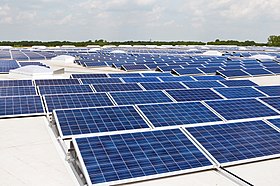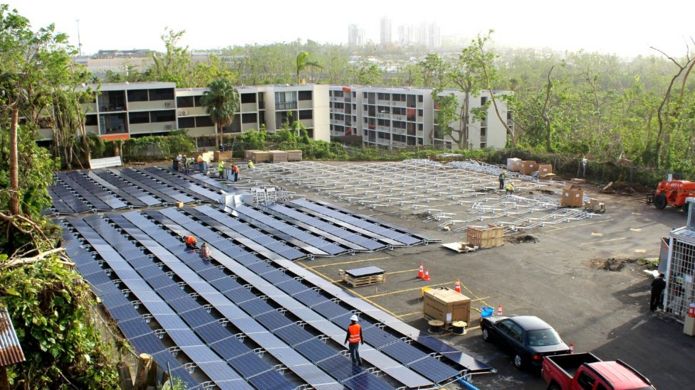Physics Behind the Solar Panel
What are Solar Panels?
 Solar panels are designed to absorb the sun's rays to be used as a source of energy to generate electricity. Instead of burning fossil fuels which pollute the earth, solar panels send out a clean supply of energy by using the power of the sun. All this may sound far-fetched, however these panels are found in everyday appliances like wristwatches or calculator. Solar panels rely on something called the, "photoelectric effect," which refers to the emission of electrons from the surface of a metal in response to incident light. Through the photoelectric effect we can harness energy from the sun. This solar power is measured to be 164 watts of electricity for every square meter of earth. This energy reaches us in the form of light and heat. Light is used to make plants grow, and heat keeps us warm in order to survive. As humans we can't use light or heat directly to run our appliances, and that's where solar panels come in. These panels convert solar energy into another form of energy called electricity, which is much easier to use.
Solar panels are designed to absorb the sun's rays to be used as a source of energy to generate electricity. Instead of burning fossil fuels which pollute the earth, solar panels send out a clean supply of energy by using the power of the sun. All this may sound far-fetched, however these panels are found in everyday appliances like wristwatches or calculator. Solar panels rely on something called the, "photoelectric effect," which refers to the emission of electrons from the surface of a metal in response to incident light. Through the photoelectric effect we can harness energy from the sun. This solar power is measured to be 164 watts of electricity for every square meter of earth. This energy reaches us in the form of light and heat. Light is used to make plants grow, and heat keeps us warm in order to survive. As humans we can't use light or heat directly to run our appliances, and that's where solar panels come in. These panels convert solar energy into another form of energy called electricity, which is much easier to use.How do Solar Panels Work?
Solar panels are a group of solar cells which convert the sun's energy into electricity. Sunlight is composed of particles known as photons that radiate from the sun. Once these photons reach these solar cells, the silicon atoms of the solar cell transfer their energy into loose electrons. Creating loose electrons is just a minuscule portion of the conversion to electricity because the solar cell needs to still group these electrons into an electrical current. However, this job is made possible because of the tightly bound arrangement of the silicon atoms. As a result, two types of silicon are created: n-type (spare electrons) and p-type (missing electrons) These two types of silicon are placed on top of one another in a solar cell, thus allowing the the n-type's spare electrons to jump into the p-type silicon. As a result, this makes the n-type silicon positively charged and the p-type negatively charges and thus creating an electrical field.
Solar Roofs in Action; Project Sunroof and Elon Musk
Project Sunroof (Google):
Project Sunroof is a solar power incentive offered by Google to encourage the use of solar panels in private residences. Project Sunroof offers a wide range of tools which allows you to see if it is worth it to instal solar panels in your year and also shows how much money you would save if you were to switch. These tools use data from Google Maps to calculate shadows of nearby buildings and temperature patterns to calculate how much money a homeowner can expect to save yearly by switching to solar power.
Elon Musk's Drive for Clean Energy (Tesla):
Elon Musk's company, Tesla, has used its solar panels and batteries to restore electricity in a children's hospital in San Juan, Puerto Rico. Elon Musk claims that this is one of the many Tesla solar project undergoing in Puerto Rico. This project was started after the island of Puerto Rico was ravaged by two powerful hurricanes in September, thus leaving the island without food, running water, and reliable power. As a result, Elon Musk offered a solution and that is installing solar panels throughout the island in different key locations so that Puerto Rico can be given a clean and reliable source of energy. The ultimate goal is to have Puerto Rico living completely off the grid.
Short Video on How Solar Panels Work:
Work's Cited:
How Do Solar Cells Work?| Explore, www.physics.org/article-questions.asp?id=51.
“Project Sunroof - Solar Calculator.” Google, Google, www.google.com/get/sunroof#p=0.
“Tesla Solar Power Arrives in Puerto Rico.” BBC News, BBC, 25 Oct. 2017, www.bbc.com/news/technology-41747065.
Woodford, Chris. “How Do Solar Cells Work?” Explain That Stuff, 25 May 2017, www.explainthatstuff.com/solarcells.html.




Comments
Post a Comment